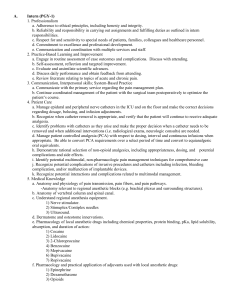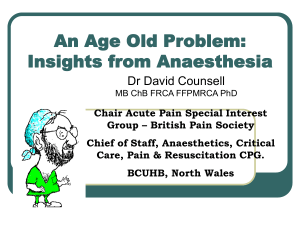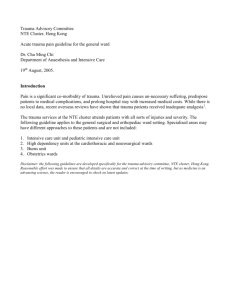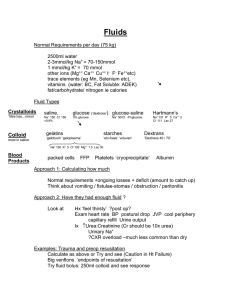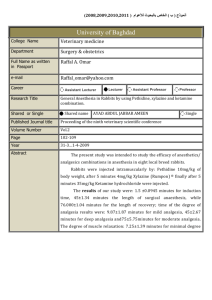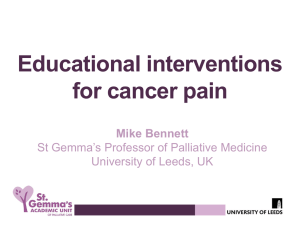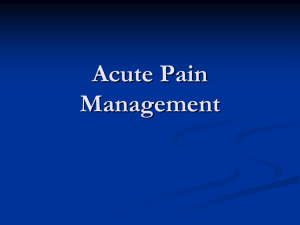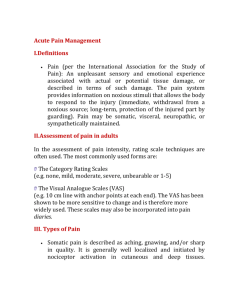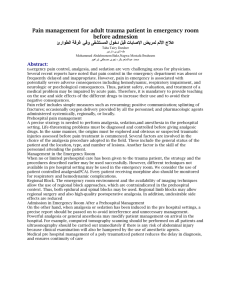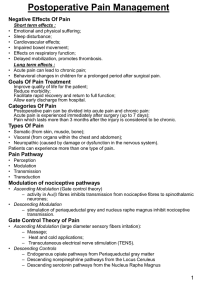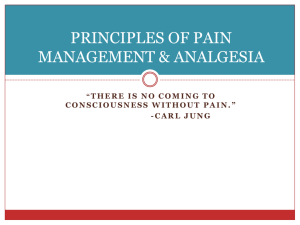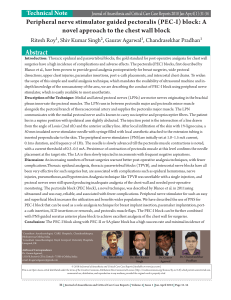File
advertisement
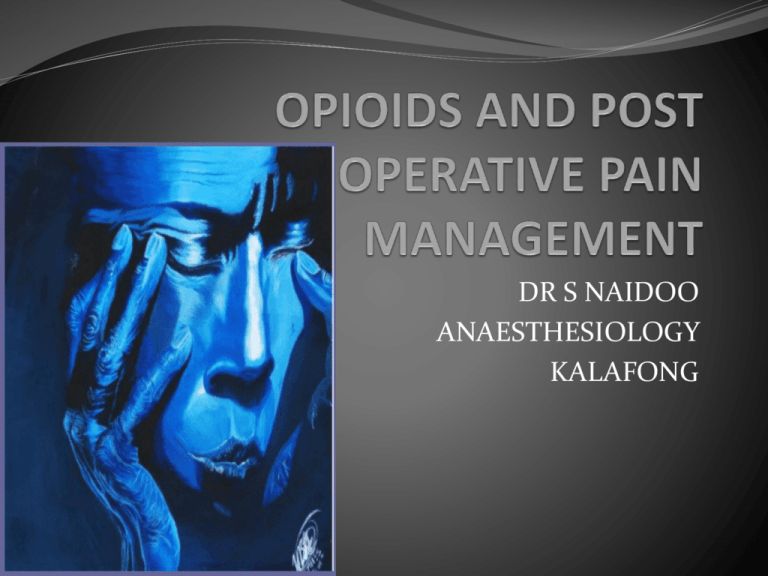
DR S NAIDOO ANAESTHESIOLOGY KALAFONG WHAT IS PAIN? Not only sensory Unpleasant and emotional experience Associated with tissue damage NOCICEPTION Latin for damage or injury Only refers to the neural response to injury All nociception causes pain BUT Other things also cause pain!!! Nociception causes ACUTE PAIN – nociceptive pain Nociception and psycho-behaviouristic factors cause CHRONIC PAIN – neurogenic pain THE BASIC PAIN PATHWAY Tissue injury stimulate free nerve endings NOCICEPTORS Afferent nerve fibres (A∂ and C) conduct stimuli centrally Peripheral afferents project into the DORSAL HORN and other areas in the SPINAL CORD SYNAPSES extend over to the SPINOTHALAMIC TRACT and up to the THALAMUS and to the CEREBRAL CORTEX FACTORS RESPONSIBLE PERIPHERAL MODULATION Locally secreted substances Sensitises the nociceptors Site of action for NSAIDs, glucocorticoids, opioids SPINAL MODULATION Neurotransmitters like glutamate, aspartate and substance P SUPRASPINAL MODULATION Descending inhibition in the dorsal horn These inhibitory tracts are opioid and ἀ-adrenergic COGNITIVE MODULATON Distraction of attention Therefore appropriate treatment agents best suited for various types of pain can be determined from causative agents PAIN Requires treatment Accompanied by unwanted side effects Acute pain untreated adequately becomes chronic in nature and even more difficult to treat And has a high morbidity SO…WHY TREAT PAIN? SIDE EFFECTS OF PAIN PULMONARY Hypoventilation, hypoxaemia, pneumonia CARDIOVASCULAR Hypertension, dysrhythmias, myocardiaI ischaemia and cardiac failure GASTRO-INTESTINAL Decreased motility GENITO-URINARY Urine retention BLOOD CLOTTING Decreased mobility prone to DVT IMMUNOLOGICAL Immunosuppression ENDOCRINOLOGICAL Stress response, decreased anabolism, increased catabolism. Na and H2O retention NON-OPIATES NSAIDS AND PARACETAMOL Useful when prostaglandins contribute to the injury ASPIRIN IBOPROFEN DICLOFENAK KETOROLAC PARACETAMOL-CODEINE COMBINATIONS ἀ₂ AGONISTS KETAMINE – 0,25mg/kg REGIONAL ANAESTHESIA The only way to blunt the afferent sympathetic influence therefore the stress response Analgesia for hours momor OPIOID RECEPTORS 3 MAIN CLASSES Mu main pharmacological effects of morphine analgesia, dependence & resp depression Kappa analgesia, resp depression, gastrointestinal effects Delta RECEPTOR PROFILE ANTAGONISTS FULL OR PARTIAL AGONISTS CENTRAL EFFECTS OF OPIOIDS Analgesia Anaesthesia Muscle rigidity Pupils Thermoregulation Euphoria OPIOIDS Drugs of choice for the treatment of severe pain Patients do not get addicted to opioids, they become tolerant Besides analgesia, opioids are sedating, suppress ventilation, alleviates coughing and can cause bronchospasm EXAMPLES OF OPIOIDS NATURAL OCCURRING MORPHINE, CODEINE PAPAVERINE, NOSCARPINE SYNTHETIC PHENYLPIPERIDINES eg fentanyl, sufentanil, etc PENTAZOCINE, BUPRENORPHINE CARDIOVASCULAR DECREASED SYMPATHETIC OUTFLOW HISTAMINE RELEASE – CVS COLLAPSE BLUNTS THE SYMPATHETIC RESPONSE TO INTUBATION RESPIRATORY SYSTEM DECREASED SENSITIVITY TO AN INCREASED PaCO₂ HYPOXIC DRIVE DECREASES CHEST WALL RIGIDITY BLUNTS THE RESPONSE TO INTUBATION BRONCHOSPASM CENTRAL NERVOUS SYSTEM REDUCED CEREBRAL O₂ CONSUMPTION, BLOOD FLOW AND INTRACRANIAL PRESSURE LITTLE EEG CHANGES MIOSIS STIMULATES THE CETZ GASTROINTESTINAL SYSTEM DECREASED GASTRIC EMPTYING SPASM OF THE SPHINCTER OF ODDI CONSTIPATION ENDOCRINE SYSTEM DECREASED RELEASE OF STRESS HORMONES ATTENUATES THE INTUBATION RESPONSE OTHER SIDE EFFECTS OF OPIOIDS NAUSEA VOMITING CONSTIPATION PRURITIS URINE RETENTION HISTAMINE RELEASE CHEST WALL RIGIDITY The application of several modalities to alleviate pain Used in combination with regional anaesthesia Administration of analgesia BEFORE surgery Found to be less effective in man than animal Including nerve blocks with or without Infusions of local anaesthesia Neuraxial blocks (spinal, epidural block and paravertebral blocks) Patient controlled analgesia Nerve Blocks Neuraxial Blocks Patient controlled analgesia So... Please remember: PAIN IS NOT AN OPTION WHEN WE AS PHYSICIANS HAVE SUCH A WIDE RANGE OF MODALITIES TO TREAT IT!
